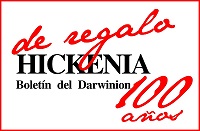LYTHRUM SALICARIA (LYTHRACEAE), NUEVA CITA PARA LA FLORA DE ARGENTINA
DOI:
https://doi.org/10.14522/darwiniana.2015.31.668Palabras clave:
Flora Argentina, Lythraceae, LythrumResumen
Lythrum es un género cosmopolita que incluye unas 36 especies de hierbas anuales y perennes. Lythrum salicaria, una de las especies de más amplia distribución geográfica del género, crece en ambientes riparios en varios países y resulta altamente invasiva fuera de su área de distribución natural. En este trabajo se informa por primera vez la presencia de una población espontánea de L. salicaria en Argentina. Se recolectaron especímenes en la localidad de Las Golondrinas, provincia de Chubut, y se elaboró una descripción morfológica a partir de los mismos. Se presenta una clave para diferenciar las tres especies de Lythrum que habitan en Argentina.
Citas
Ågren, J. 1996. Population size, pollinator limitation, and seed set in the self-incompatible herb Lythrum salicaria. Ecology 77: 1779-1790. DOI: http://dx.doi.org/10.2307/2265783
Dimitri, M. J. 1979. Lythrum, en L. R. Parodi (ed.), Enciclopedia Argentina de Agricultura y Jardinería, 3ra ed., actualizada por M. J. Dimitri, vol. 2, pp. 814. Buenos Aires: ACME.
Edwards, K. R. 2012. Lythrum salicaria L. (purple loosestrife), en R. A. Francis (ed.), A handbook of Global Freshwater Invasive Species, pp. 91-102. London: Earthscan.
Farnsworth, E. J. & D. R. Ellis. 2001. Is purple loosestrife (Lythrum salicaria) an invasive threat to freshwater wetlands? Conflicting evidence from several ecological metrics. Wetlands 21: 199-209. DOI: http://dx.doi.org/10.1672/0277-5212(2001)021[0199:IPLLSA]2.0.CO;2
Flanagan, R. J.; R. J. Mitchell & J. F. Karron. 2010. Increased relative abundance of an invasive competitor for pollination, Lythrum salicaria, reduces seed number in Mimulus ringens. Oecologia 164: 445-454. DOI: http://dx.doi.org/10.1007/s00442-010-1693-2
Gaudet, C. L. & P. A. Keddy. 1995. Competitive performance and species distribution in shoreline plant communities: a comparative approach. Ecology 76: 280-291. DOI: http://dx.doi.org/10.2307/1940649
Graham, S. A. 2008. Lythraceae, en F. O. Zuloaga, O. Morrone & M. J. Belgrano (eds.), Catálogo de las Plantas Vasculares del Cono Sur (Argentina, sur de Brasil, Chile, Paraguay y Uruguay). Monographs in Systematic Botany from the Missouri Botanical Garden 107: 2433-2441.
Keddy, P. A.; L. Twolan-Strutt & I. C. Wisheu. 1994. Competitive effect and response rankings in 20 wetland plants: are they consistent across three environments? Journal of Ecology 82: 635-643. DOI: http://dx.doi.org/10.2307/2261270
Lourteig, A. 1943. Lythraceae argentinae. Lilloa 9: 317-421.
Lourteig, A. 1988. Lythraceae, en M. N. Correa (dir.), Flora Patagónica. Colección Científica del Instituto Nacional de Tecnología Agropecuaria 8(5): 249-252.
Mabberley, D. J. 2008. Mabberley’s Plant-Book: a portable dictionary of plants, their classification and uses, 3rd ed., pp. 508 New York: Cambridge University Press.
Nagel, J. M. & K. L. Griffin. 2001. Construction cost and invasive potential: comparing Lythrum salicaria (Lythraceae) with co-occurring native species along pond banks. American Journal of Botany 88: 2252-2258. DOI: http://dx.doi.org/10.2307/3558387
Pyšek, P.; D. M. Richardson; M. Rejmánek; G. L. Webster; M. Williamson & J. Kirschner. 2004. Alien plants in checklists and floras: towards better communication between taxonomists and ecologists. Taxon 53: 131-143. DOI: http://dx.doi.org/10.2307/4135498
Sykes, W. R. 1988. Lythraceae, en C. J. Webb, W. R. Sykes & P. J. Garnock-Jones (eds.) Flora of New Zealand, vol. 4, Naturalised Pteridophytes, Gymnosperms, Dicotyledons, pp. 816-820. Christchurch: Botany Division, Department of Scientific and Industrial Research.
Thiers, B. [permanentemente actualizado, consulta 2015] Index Herbariorum: a global directory of public herbaria and associated staff. New York Botanical Garden’s Virtual Herbarium, http://sweetgum.nybg.org/ih
Velayos Rodríguez, M. 1997. Lythrum, en S. Castroviejo, C. Aedo, M. Laínz, F. Muñoz Garmendia, G. Nieto Feliner, J. Paiva & C. Benedí (eds.), Flora Ibérica 8, pp. 15-25. Madrid: Real Jardín Botánico, CSIC.
Waites, A. R. & J. Ågren. 2004. Pollinator visitation, stigmatic pollen loads and among-population variation in seed set in Lythrum salicaria. Journal of ecology 92: 512-526. DOI: http://dx.doi.org/10.1111/j.0022-0477.2004.00893.x
Weihe, P. E. & R. K. Neely. 1997. The effects of shading on competition between purple loosestrife and broad-leaved cattail. Aquatic Botany 59: 127-138. DOI: http://dx.doi.org/10.1016/S0304-3770(97)00023-5
Wiersema, J. H. & B. León. 2013. World Economic Plants. A standard reference, 2nd ed., pp. 422. London: CRC Press.
Publicado
Cómo citar
Número
Sección
Licencia

A partir de 2012, esta obra está licenciada bajo una Licencia Creative Commons Atribución-NoComercial 2.5 Argentina .
Cualquier obra derivada deberá estar previamente autorizada con nota escrita de los editores.







